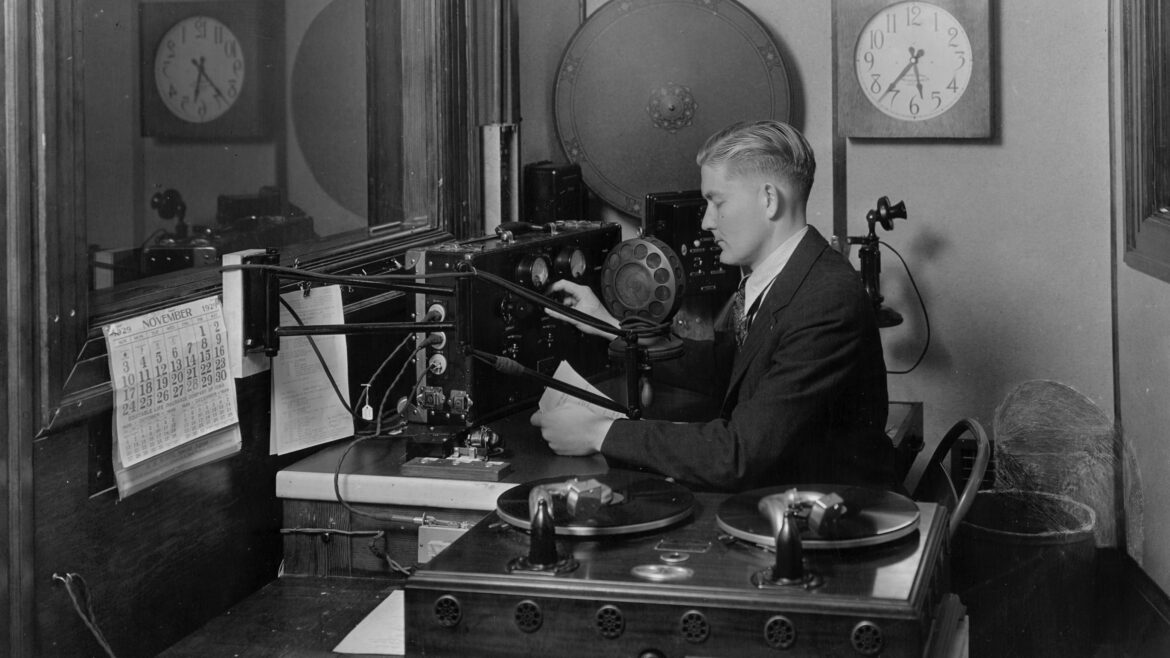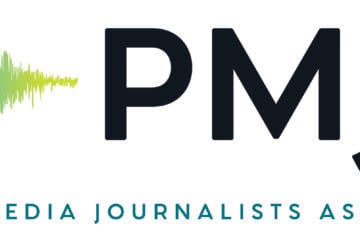Why public media’s past might be its future

OPB
A radio host working in the studio at KOAC, OPB’s first radio station, in the 1920s.
Since its founding in the 1920s, public broadcasting played two important and inseparable roles — the creation of content and the distribution of content. In those early years, creating content required expensive equipment that was available only to professionals; distributing it required an FCC license. Both were huge barriers to entry for content creators and distributors for decades.
These barriers no longer exist. Content creators can shoot and record video or audio on smartphones and upload their content to YouTube, Spotify, TikTok or Facebook. Audiences can access the media they want to watch or listen to at times that they choose.
Public radio and television content is freely available via digital platforms and apps, but both have experienced steep audience declines for their linear broadcast services. For public television in particular, the losses are precipitous and alarming. The traditional business of program distribution, which evolved over decades, is at risk of faltering.
As local public media organizations evaluate how to adapt in this changed environment, it’s important to remember that content creation was the most dominant activity of stations until the 1960s. Programming had to be produced locally because there were no national organizations of any scale to commission programming or coordinate distribution or scheduling. Public broadcasting was truly a local enterprise. There was quite a lot of variety in the service from place to place.
Broadcast distribution became more dominant after passage of the Public Broadcasting Act of 1967. The funding it provided enabled creation of strong national organizations to manage and distribute national programs. Changes in technology allowed for nimbler and less expensive interconnection among stations. Things that weren’t possible in the past became possible, such as live coverage of the Watergate hearings and a common schedule of programs.
Audiences grew for public broadcasting in an environment of limited competition, and this led to significant gains in membership and sponsorship. As programming became more nationalized, PBS and NPR became brand names. Both services took on more of the character of broadcast networks by commissioning, distributing and — in NPR’s case — producing national programs.
By the mid‐1970s onward, PBS and NPR programming became the driving force for audience and revenue growth at most stations. Money flowed to national producers and distributors. Stations’ program acquisition budgets grew. Local productions, which were expensive and often served fewer people, were deemphasized in many places.
This shift from local to national content creation in public television was not an accident; it was by design. A 1991 CPB-commissioned study from the Boston Consulting Group recommended that public television reduce its investment in local programming. The economics were much more favorable if stations pooled their funds for national programs. At many stations, the ability to create engaging and impactful local content began a long decline.
The Boston Consulting Group’s study landed one year after the broadcast debut of The Civil War, the first major documentary series from Ken Burns, which achieved a record-breaking 9 rating across metered markets in 1990. Public television’s audience growth continued through the decade but began declining in the early 2000s. Downton Abbey premiered in January 2011 and provided a boost for a few years. But today, the average PBS prime-time rating is half of what it was a decade ago. The annual average of full-day cume audiences dropped from 75% in 2017 to 40% in 2023.
Radio formats enable growth of local newsrooms
Public radio had a different trajectory. Because radio programs were less expensive to produce, the economic imperative pushing stations toward national programming wasn’t as powerful.
Since its creation in 1979, NPR’s Morning Edition has allowed insertion of local segments that are shorter than standard broadcast length. This magazine format helped set off the growth of local newsrooms, a small step that eventually led to public radio’s emergence as a force in local journalism.
For many years, most public radio stations offered a mix of programming rather than a consistent format. In 1991, WBUR in Boston became the first all-news public radio station and experienced rapid audience growth. Other NPR member stations followed, and public radio’s audience growth accelerated. Audiences peaked in 2017 and began to drop. When the coronavirus interrupted commuting patterns, the declines in listenership accelerated.
Today, erosion of broadcast audiences is creating a sense of alarm across public media. Public television’s audience is not transitioning effectively from linear broadcast to digital consumption. A recent TRAC Media study comparing data from 19 stations from 2022 to 2023 found that losses of 808,000 linear viewers were offset by gains of only 55,000 on-demand viewers. For every 15 linear viewers they lost, these stations only picked up one on-demand viewer.
Unless these trends reverse, the business model and public service rationale based mostly on the linear distribution of programming “leased” from PBS, NPR and others will not be sustainable. Yet, with the decline of ad-supported daily newspapers and the trend toward nationalization of media, there is a growing need and appetite for locally and community‐focused journalism, civic information, education and connections.
The need and the opportunity for public media are content-driven and local. To succeed in this environment, local public media organizations need to focus on creating original content and building digital platforms and products to deliver that content. They also need to create new ways to directly engage with and respond to the needs of local communities.
I’d also argue that the term “station” needs to be retired because it emphasizes public media’s distribution function and not our local roots and focus as a key differentiator. When describing OPB to the outside world, I refer to it as a “public service journalism organization that also operates television and radio networks.” Leaders of other organizations, such as Cleveland’s Ideastream, LAist in Los Angeles, and networks in Maine, Vermont and Connecticut are thinking along similar lines.
In some ways, public media is becoming more like its early days: an ecosystem of locally focused organizations serving communities with journalism, civic information, cultural expression and educational content. The conception of public media as a network of stations focused on distributing a homogenous nationalized linear broadcast service isn’t as powerful — or as sustainable.
We don’t have much time to make this transition. Media habits are shifting quickly. We don’t fully understand the ultimate destination for a sustainable public media system and there are no GPS directions to get us there. But here are ways that we can begin the journey:
Acknowledge the challenges and talk about them with candor and courage. There is a lack of candid conversation in public media about the changes occurring around us. National convenings often are celebrations of the status quo rather than opportunities for discussion and debate. Our culture doesn’t support speaking out openly and with courage. Many fear that doing so for attribution would lead to retribution. We need to create an intentional culture of constructive engagement based on “What’s said here stays here, what’s learned here leaves here.”
Don’t throw in the towel on linear TV and radio … yet. We still have significant and loyal audiences who provide the bulk of our contributed revenue. Serving linear audiences while we have them will provide a bridge to the future. It’s our cash cow — a source of net revenue to be invested in products and platforms that will grow in the future.
Focus more on broadband while we gradually pivot from broadcast. Consumers are moving away from proprietary carriers like broadcast, cable and satellite toward common carriers (e.g., broadband and wireless internet). Household cable penetration reached its height in 2011 and is decreasing every year. It’s now used in less than 60% of homes. Andrew Finlayson from Smith Geiger shared a stunning fact at the Major Market Group’s March 2024 meeting: Only 47% of homes now use linear TV on a weekly basis. As several members of the MMG mentioned during the meeting, we need to accelerate our efforts to move our most loyal viewers and members to consuming our content via broadband, apps, etc., before they become adrift in a sea of streaming choices.
Shift focus radically to content and audience engagement at the local level. Some organizations have strong assets to build on. If you do, protect them while building them into digital assets. If you don’t, start fresh with digital platforms and future consumers in mind. CPB is providing training in this area in partnership with the Poynter Institute. Take advantage of it.
Let go of the idea that PBS, NPR, CPB or any other entity is our savior. Leaders of local public media organizations must take full ownership and responsibility, along with our governing boards, for the future of our public service mission. PBS and NPR have their own ambitions and challenges. They are scrambling to create their own future. We should expect them to be good partners, but they can’t and won’t solve our problems, even if that’s what they appear to be promising.
Reinvent how we harness technology at scale for the coming ecosystem of local digital‐first public media organizations. Our current technology is rooted in broadcast interconnection designed and operated by PBS and NPR for a world that is disappearing. We need new technology tools for the future — content management systems, application program interfaces, apps and more. The teams that provide broadcast tools won’t likely be effective in creating the tech we will need. We need an entirely different approach that centers the needs of local public media organizations.
Stop letting 15% of system funding drive 100% of the strategy. Federal funding (or concerns about it) plays an outsized role in strategic decisions. We fear making necessary changes if there’s even a small possibility of impacting federal funding. We cannot evolve for the future if we are frozen in place by fear.
Lean into public service and the power of being free. Free, universal access to public media is one of our historic values and makes us unique. We can’t forget these values as we adapt our business model to new realities. Yes, Passport should have a better user experience. But the free app, over-the-top streaming and other services should not be forgotten in our search for revenue. Throughout our history, many organizations got off track by following the money at the expense of public service.
In my 44 years in public media, I’ve experienced a lot of change. And I’ve seen public media rise to the occasion to respond to our shared challenges. The changes ahead could be more significant than any in the past. But I am convinced that there is an important role for public media for years to come if we are willing to adapt and evolve. And to face the future with candor, courage and commitment.
Steve Bass served as president and CEO of Oregon Public Broadcasting from 2006 to 2024. He began his public media career as an intern at WHA in Madison, Wis., and spent a decade at PBS, seven years at GBH in Boston and seven years at Nashville Public Television. Along the way he served on the boards of NPR, PRX and the Station Resource Group, and chaired the boards of Greater Public and America’s Public Television Stations.








I suggest boiling it down considerably: what is your station going to do to fill the, approx, seven hours every weekday you’ll have to fill if you drop Morning Edition and All Things Considered?
This is a big, big question with a lot of factors to consider in answering it. But it’s also the core issue at hand: can a local member station survive without NPR or not?
And I would go a step further: I don’t like how over-reliant a lot of member stations are on unpaid volunteer airstaff already. I believe quite strongly that anyone producing content, that’s of sufficient quality to deserve airtime, is someone who deserves to be fairly compensated for their time and effort. So that means volunteer DJ’s are out as a potential time-filler, too.
Okay, so, what’s the answer? How do stations survive without ME & ATC?
Something I’ve been saying for over 25 years. Look to the early years of innovation and experimentation, when public television was a hothouse for burgeoning formats and bold new approaches, especially at the local station level – it doesn’t have to cost a fortune if it captures the zeitgeist and feels true to what’s bubbling up in your communities. And a broader range of locally-developed content can have massive implications for national programming as well.